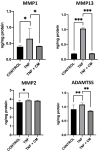The Therapeutic Potential of Adipose-Derived Mesenchymal Stem Cell Secretome in Osteoarthritis: A Comprehensive Study
- PMID: 39457070
- PMCID: PMC11508730
- DOI: 10.3390/ijms252011287
The Therapeutic Potential of Adipose-Derived Mesenchymal Stem Cell Secretome in Osteoarthritis: A Comprehensive Study
Abstract
Osteoarthritis (OA) is a degenerative joint disease characterized by cartilage degradation and inflammation. This study investigates the therapeutic potential of secretome derived from adipose tissue mesenchymal stem cells (ASCs) in mitigating inflammation and promoting cartilage repair in an in vitro model of OA. Our in vitro model comprised chondrocytes inflamed with TNF. To assess the therapeutic potential of secretome, inflamed chondrocytes were treated with it and concentrations of pro-inflammatory cytokines, metalloproteinases (MMPs) and extracellular matrix markers were measured. In addition, secretome-treated chondrocytes were subject to a microarray analysis to determine which genes were upregulated and which were downregulated. Treating TNF-inflamed chondrocytes with secretome in vitro inhibits the NF-κB pathway, thereby mediating anti-inflammatory and anti-catabolic effects. Additional protective effects of secretome on cartilage are revealed in the inhibition of hypertrophy markers such as RUNX2 and COL10A1, increased production of COL2A1 and ACAN and upregulation of SOX9. These findings suggest that ASC-derived secretome can effectively reduce inflammation, promote cartilage repair, and maintain chondrocyte phenotype. This study highlights the potential of ASC-derived secretome as a novel, non-cell-based therapeutic approach for OA, offering a promising alternative to current treatments by targeting inflammation and cartilage repair mechanisms.
Keywords: conditioned medium; inflammatory cytokines; mesenchymal stem cells; osteoarthritis; secretome.
Conflict of interest statement
The authors declare no conflict of interest.
Figures






Similar articles
-
Mesenchymal Stem Cells and Secretome as a New Possible Approach to Treat Cartilage Damage: An In Vitro Study.Biomolecules. 2024 Aug 26;14(9):1068. doi: 10.3390/biom14091068. Biomolecules. 2024. PMID: 39334835 Free PMC article.
-
The therapeutic effect of bone marrow-derived mesenchymal stem cells on osteoarthritis is improved by the activation of the KDM6A/SOX9 signaling pathway caused by exposure to hypoxia.J Cell Physiol. 2020 Oct;235(10):7173-7182. doi: 10.1002/jcp.29615. Epub 2020 Feb 5. J Cell Physiol. 2020. PMID: 32020624
-
Muscle cell-derived factors inhibit inflammatory stimuli-induced damage in hMSC-derived chondrocytes.Osteoarthritis Cartilage. 2013 Jul;21(7):990-8. doi: 10.1016/j.joca.2013.04.011. Epub 2013 Apr 20. Osteoarthritis Cartilage. 2013. PMID: 23611899 Free PMC article.
-
Molecular and biophysical mechanisms regulating hypertrophic differentiation in chondrocytes and mesenchymal stem cells.Eur Cell Mater. 2012 Jul 24;24:118-35; discussion 135. doi: 10.22203/ecm.v024a09. Eur Cell Mater. 2012. PMID: 22828990 Review.
-
Therapeutic potential of SOX family transcription factors in osteoarthritis.Ann Med. 2025 Dec;57(1):2457520. doi: 10.1080/07853890.2025.2457520. Epub 2025 Jan 31. Ann Med. 2025. PMID: 39887675 Free PMC article. Review.
Cited by
-
A review of adipose-derived mesenchymal stem cells' impacts and challenges: metabolic regulation, tumor modulation, immunomodulation, regenerative medicine and genetic engineering therapies.Front Endocrinol (Lausanne). 2025 May 29;16:1606847. doi: 10.3389/fendo.2025.1606847. eCollection 2025. Front Endocrinol (Lausanne). 2025. PMID: 40510466 Free PMC article. Review.
-
TNF-Alpha Inhibitor Prevents Cigarette Smoke Extract-Induced Cell Death in Osteoarthritis-Derived Chondrocytes in Culture.Cells. 2025 Mar 25;14(7):489. doi: 10.3390/cells14070489. Cells. 2025. PMID: 40214444 Free PMC article.
-
A preliminary bioinformatic screen to identify SRI SMC2 PSIP1 TLE4 and MSX1 as potential diagnostic and prognostic markers of osteoarthritis.Sci Rep. 2025 Aug 20;15(1):30583. doi: 10.1038/s41598-025-13575-2. Sci Rep. 2025. PMID: 40835866 Free PMC article.
-
Impact of exosomes derived from adipose stem cells on lymphocyte proliferation and phenotype in mouse skin grafts.Extracell Vesicles Circ Nucl Acids. 2025 Mar 7;6(1):141-157. doi: 10.20517/evcna.2024.52. eCollection 2025. Extracell Vesicles Circ Nucl Acids. 2025. PMID: 40206795 Free PMC article.
References
-
- Fernandes J.C., Martel-Pelletier J., Pelletier J.-P. The Role of Cytokines in Osteoarthritis Pathophysiology. Biorheology. 2002;39:237–246. - PubMed
-
- Tetlow L.C., Adlam D.J., Woolley D.E. Matrix Metalloproteinase and Proinflammatory Cytokine Production by Chondrocytes of Human Osteoarthritic Cartilage: Associations with Degenerative Changes. Arthritis Rheum. 2001;44:585–594. doi: 10.1002/1529-0131(200103)44:3<585::AID-ANR107>3.0.CO;2-C. - DOI - PubMed
MeSH terms
Substances
Grants and funding
LinkOut - more resources
Full Text Sources
Medical
Molecular Biology Databases
Research Materials
Miscellaneous

